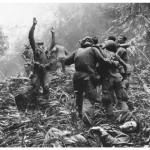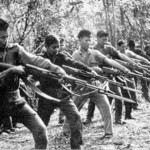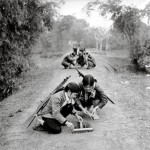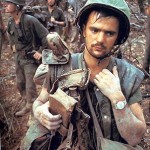
No war is easy for those who fight it and each conflict brings its own challenges. Soldiers in the Vietnam War endured many hardships and faced many problems, some of them seemingly insurmountable. Combatants on both sides faced physical challenges posed by the climate, terrain and wildlife of the country. They also struggled with logistical problems, as well as the complex political situation in Vietnam. On top of that, the Vietnam War was a conflict with few conventional military objectives. There was no war front to advance, no safe region to defend, not even a well-defined theatre in which to operate. The Vietnam conflict was a 360-degree war where soldiers – particularly Americans and Westerners – might encounter attacks, ambushes and booby traps at any place or time. It was a conflict where territory changed hands frequently, people moved freely and their political loyalties were often unclear. It was a shiftless and often vague struggle between a powerful conventional military force and a guerrilla army that operated in the shadows.
The troops of North Vietnam and the Viet Cong were under-resourced and poorly equipped, at least in comparison to American soldiers. They did have some significant advantages, however, including a close knowledge of the local people, language and terrain. The NVA and Viet Cong drew lessons from their eight-year long war with France (1946-54), which gave them valuable experience fighting a major Western power. The communist leadership adopted guerrilla methods and avoided major battles. It was a reiteration of the ‘elephant and tiger’ strategy previously used against the French – only the ‘American elephant’ was larger and potentially more dangerous. Hanoi’s goal was to prolong the war for as long as it could while inflicting casualties on South Vietnamese and American personnel. They knew that America’s involvement in Vietnam was costly; that its political and military leaders were impatient; and that the American public would tire of the war and exert pressure on their leaders.

The success of this strategy hinged on training and discipline. Though essentially a civilian militia, the Viet Cong also had a significant number of men who were highly trained and well drilled regular soldiers; consequently, they saw themselves as professionals. There were more than 50 Viet Cong training bases or centres across South Vietnam, where personnel were given instruction in weapons handling, explosives, radio operation, subterfuge and guerrilla warfare tactics. To ensure loyalty and discipline, Viet Cong volunteers were also tutored in the historical and political background of the conflict. Not all Viet Cong were so well trained. A sizeable number were reservists: civilian farmers, workers, teenagers and boys who took up arms when necessary. These reservists trained occasionally, if at all. Some were not even volunteers; they participated in the Viet Cong under pressure from family members or local cadres.

Viet Cong troops had no standard equipment and used whatever weapons were available. The most common Viet Cong weapon was the Chinese-made AK47 submachine gun, though some soldiers used confiscated French or Japanese rifles. Soviet-made artillery, grenades and mortars were also used, though they were in much shorter supply. Always short of small arms, the Viet Cong became masters of adaptation. They used improvised or hand made munitions, constructed by soldiers and sympathetic villagers from whatever material could be stolen or scrounged. Weapons were fashioned from anything remotely dangerous, from scavenged tin cans to discarded wire. The most important ingredients – gunpowder and explosive materials – were often provided by the enemy. In a single year, unexploded American bombs left an estimated 20,000 tons of ordnance scattered over the Vietnamese countryside. After air raids and bombing runs, Viet Cong volunteers retrieved these ‘duds’ and the dangerous business of creating new weapons began. Viet Cong units also built primitive weapons and booby traps, like pits containing ‘Punji stakes’ (sharpened spikes) or venomous snakes.
Evasion and concealment were hallmarks of the Viet Cong. In the mountains and jungles, where landscape and foliage served as cover, hiding from the enemy was comparatively easy. In the plains and closer to the cities, the Viet Cong relied on underground tunnel systems, some of which were large and complex. Tunnel building predated the arrival of the Americans but the Viet Cong used it extensively during the Vietnam War. Every civilian in a Viet Cong area was expected to dig three feet of tunnel per day. The tunnels were used not just as hiding places or shelter. They also served as headquarters, barracks, warehouses, munitions dumps, hospitals and kitchens. The largest tunnel systems were in the Cu Chi district and the ‘Iron Triangle’, just a handful of miles from Saigon. These networks contained more than 120 kilometres of tunnel.
“Who is the enemy? How can you distinguish between the civilians and the non-civilians? The same people who come and work in the bases at daytime, they just want to shoot and kill you at nighttime. So how can you distinguish between the two? The good or the bad? All of them look the same.”
Vanardo Simpson, US soldier
American soldiers, in contrast, were better armed, better equipped and more extensively trained than the Viet Cong. The majority of Americans sent to Vietnam completed eight weeks of basic training, followed by courses in infantry, artillery, engineering and other specialisations, each lasting between two and six months. Soldiers deployed to Vietnam were also given a fortnight’s specialist training before leaving the US. On arrival in Vietnam these newcomers – referred to as ‘cherries’ by more experienced soldiers – were given another fortnight’s training and orientation. Whether this preparation was adequate or specialised enough for the situation in Vietnam is doubtful. In the 1960s America’s combat troops formed the most powerful offensive battlefield force on the planet – but the Vietnam War was far too complex to be won only on the battlefield.

The effectiveness of American soldiers was undermined not by a lack of skill or courage, but by a range of factors: local conditions, unclear military objectives, the highly politicised nature of the war, the stealth and inventiveness of their enemy. Vietnam’s subtropical climate, terrain and fauna all took their toll on American troops. The heat, humidity, monsoonal rain and groundwater meant that uniformed GIs were almost constantly drenched with water or sweat. Patrols into the ‘boonies’ (rural or remote areas) often had to traipse through thick jungle, sharp vines and foliage, up and down steep rises and ditches, through swamps and across flooded rice paddies. Vietnam’s wildlife posed its own dangers. American soldiers encountered malarial mosquitoes, leeches, ticks, fire ants and 30 different kinds of venomous snake. One historian estimates between 150 and 300 US personnel died in Vietnam from the effects of snakebite.
The nature of the Vietnam War also took a personal toll on US soldiers. Though trained to follow orders and disregard external factors, most American GIs were acutely aware of the tremendous difficulties they faced. Their mission to secure South Vietnam, gain the trust and loyalty of the people and eradicate the Viet Cong often seemed impossible. Many combat operations had no discernible outcomes other than ‘body counts’, which themselves were no more than estimates. An area could be cleared of Viet Cong in the morning but be back in enemy hands at sundown, after US troops had departed. Vietnamese villagers were sometimes welcoming and sometimes treacherous. Most were indifferent to American soldiers, very few of whom could speak their language. As one US soldier in Vietnam asked: “What am I doing here? We don’t take any land. We don’t give it back. We just mutilate bodies. What the f–k are we doing here?”

Disillusionment with the war was coupled with psychological trauma. Most US soldiers who had spent time ‘in country’ had seen fellow servicemen, sometimes their friends, killed or disfigured by sniper fire, mines or booby traps. The Viet Cong who laid these traps were reluctant to engage in conventional warfare, so American soldiers felt deprived of the opportunity for retaliation or ‘payback’. The frustration in some units contributed to a breakdown in discipline. The practice of ‘fragging‘ – killing or injuring an unpopular superior officer by activating a fragmentation grenade close by – became relatively common (one source cites 730 cases between 1969 and 1971). Illicit drugs like marijuana, opium, morphine and heroin were widely available to American soldiers in Vietnam. In some combat units, up to 80 per cent of men were casual or habitual drug users. The US military did little to combat drug abuse until 1971.

1. Soldiers on both sides faced many difficulties and challenges during the Vietnam War – including climate, terrain, the complex political situation and unclear military objectives.
2. Some Viet Cong soldiers were uniformed and highly trained, however, most were volunteers and reservist farmers who received only occasional training, if any at all.
3. The Viet Cong used Chinese and Soviet-supplied weapons but also relied on makeshift explosives and booby traps. They utilised guerrilla tactics, such as complex tunnel systems.
4. American soldiers, in comparison, were well equipped and given months of basic and specialist training before their deployment in Vietnam.
5. Many US soldiers became disillusioned with the war, its complexities and its outcomes. This led to problems such as the ‘fragging’ of officers and the use of narcotics.
© Alpha History 2018. Content on this page may not be republished or distributed without permission. For more information please refer to our Terms of Use.
This page was written by Jennifer Llewellyn, Jim Southey and Steve Thompson. To reference this page, use the following citation:
J. Llewellyn et al, “Vietnam War soldiers”, Alpha History, accessed [today’s date], https://alphahistory.com/vietnamwar/vietnam-war-soldiers/.
